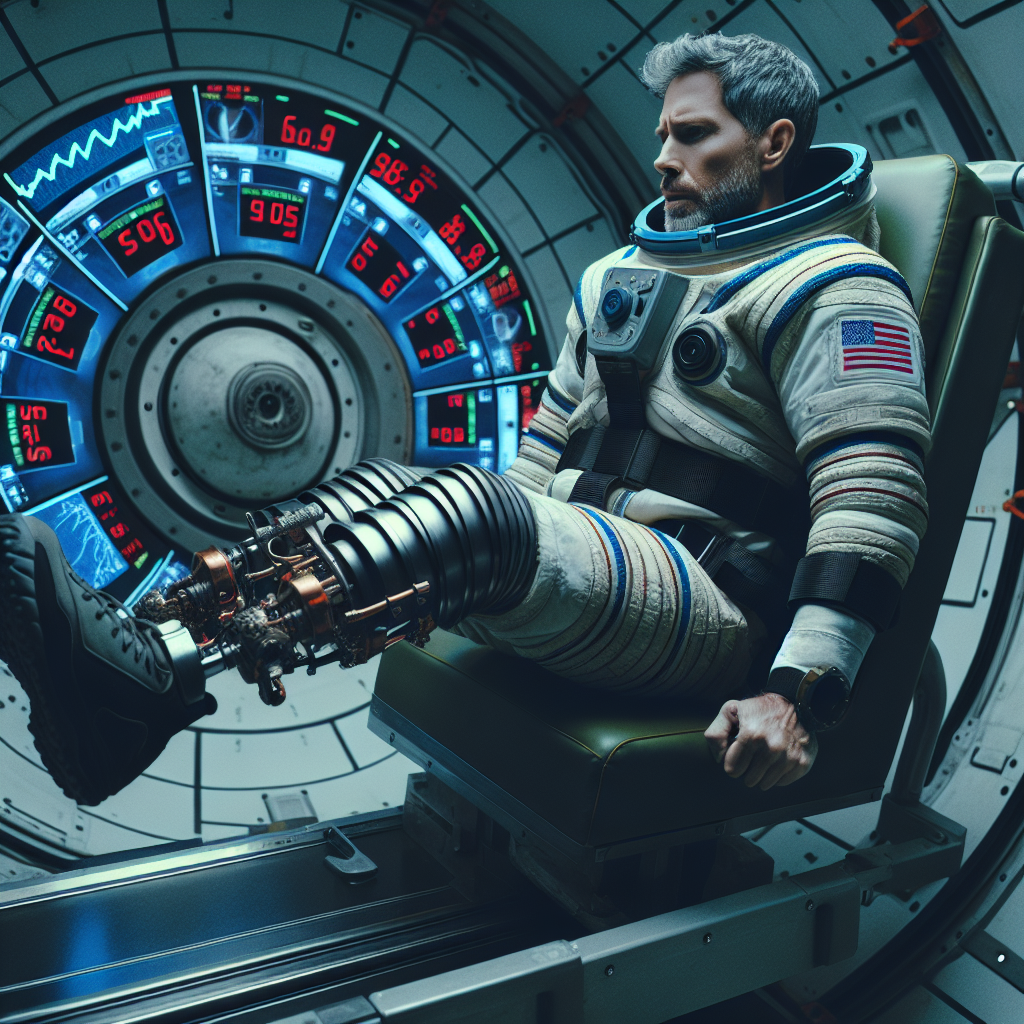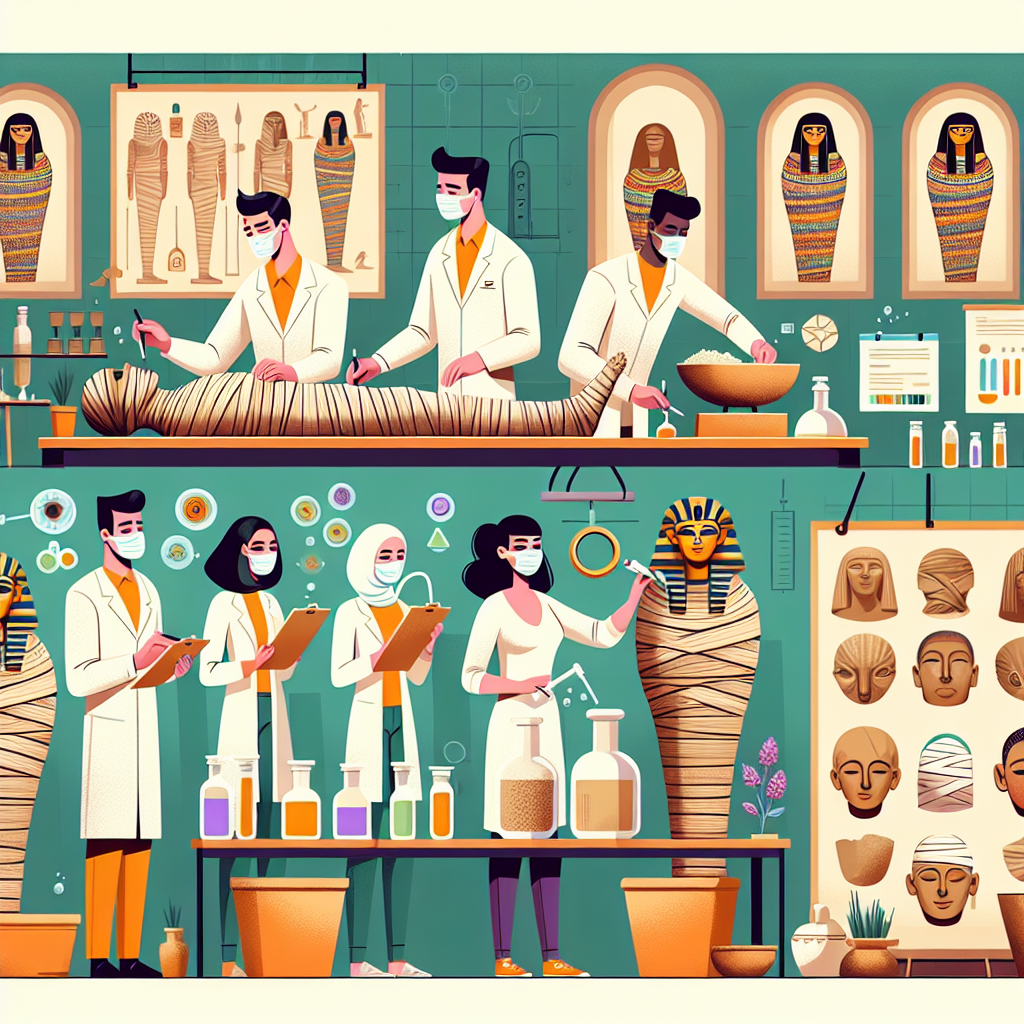John McFall, a former Paralympian, is working with the European Space Agency (ESA) on a groundbreaking study to determine if it is possible for individuals with physical disabilities to live and work in space. As part of his astronaut training, McFall recently underwent a test in a giant centrifuge to simulate the gravitational forces experienced during a rocket launch and re-entry. The test went well, and McFall’s amputation did not pose any significant issues. This study aims to identify any necessary adaptations to spacecraft, spacesuits, or prosthetic limbs to make space travel safe for individuals with disabilities.
McFall, who lost the lower part of his right leg in a motorcycle accident, is currently assessing his running blade, which he uses for exercise. He has also tested a special anti-gravity treadmill that recreates weightless conditions experienced on the International Space Station (ISS). McFall noticed that his blade did not work as well when he was lighter, indicating the need for a more flexible blade. Additionally, during a parabolic flight, he discovered that his microprocessor prosthetic leg would require recalibration. He believes he may need multiple prosthetic legs for different activities on the ISS.
The ESA’s project with McFall is the first of its kind, as previous space agencies would not have considered individuals with disabilities for astronaut positions. However, the head of the European Astronaut Centre, Frank De Winne, believes that people with disabilities, like McFall, have unique talents that can be harnessed for space missions. McFall’s family has also relocated to Germany to support him during the study.
McFall is halfway through the project and has not encountered any obstacles that would prevent him from participating in a space mission. He hopes that his journey will challenge people’s perceptions of what individuals with disabilities are capable of and inspire others to pursue their dreams. Ultimately, McFall wants to be seen as just John, an astronaut who happens to have a physical disability.
Original news source: The man on a mission to open up space to disability (BBC)
🎧 Listen:
Slow
Normal
Fast
📖 Vocabulary:
| 1 | groundbreaking | Introducing new ideas or methods; innovative |
| 2 | centrifuge | A machine that uses centrifugal force to simulate gravitational effects |
| 3 | gravitational | Relating to the force that attracts a body toward the center of the earth |
| 4 | re-entry | The act of returning to Earth’s atmosphere from space |
| 5 | amputation | The surgical removal of a limb or part of a limb |
| 6 | adaptations | Changes made to fit new conditions or environments |
| 7 | prosthetic | An artificial device that replaces a missing body part |
| 8 | treadmill | A device used for walking or running while staying in one place |
| 9 | recalibration | The process of adjusting or correcting something again |
| 10 | parabolic | Shaped like a parabola; having a curved path |
| 11 | harnessed | Utilized or put to use effectively |
| 12 | perceptions | The way in which something is regarded, understood, or interpreted |
| 13 | astronaut | A person trained to travel and perform tasks in space |
| 14 | obstacles | Things that block one’s way or prevent progress |
| 15 | inspire | To fill someone with the urge or ability to do or feel something |
Group or Classroom Activities
Warm-up Activities:
– News Summary
Instructions: Divide the class into small groups and assign each group a different section of the article. In their groups, students must read and discuss their section, then work together to create a concise summary of the key points. Each group will then present their summary to the class.
– Word Association
Instructions: Write the word “space” on the board. Ask students to brainstorm as many related words as they can in one minute. After one minute, have students share their words and write them on the board. Encourage discussion and explanation of the connections between the words.
– Sketch It
Instructions: Provide each student with a piece of paper and a pencil. Ask them to choose a key moment or concept from the article and sketch it on their paper. After a few minutes, have students share their sketches with a partner and explain what they drew. Encourage discussion and interpretation of the sketches.
– Keyword Taboo
Instructions: Write a list of keywords from the article on separate slips of paper. Divide the class into two teams. One student from each team will come to the front of the class and pick a slip of paper. Without saying the keyword, they must try to describe it to their team using synonyms, definitions, or examples. The team must guess the keyword within a time limit. The team with the most correct guesses wins.
– Pros and Cons
Instructions: Divide the class into pairs or small groups. Assign each group a side of the argument: “Should individuals with disabilities be considered for astronaut positions?” One group will argue in favor (pros) and the other group will argue against (cons). Give students a few minutes to brainstorm their arguments, then have a class debate where each group presents their points. Encourage students to use evidence from the article to support their arguments.
🤔 Comprehension Questions:
1. What is the purpose of the study being conducted by the European Space Agency (ESA) and John McFall?
2. How did McFall’s amputation affect his test in the giant centrifuge?
3. What did McFall discover about his running blade during his assessment?
4. What did McFall learn about his microprocessor prosthetic leg during the parabolic flight?
5. Why is the ESA’s project with McFall considered groundbreaking?
6. How has McFall’s family supported him during the study?
7. Has McFall encountered any obstacles that would prevent him from participating in a space mission?
8. What is McFall’s ultimate goal with this project?
Go to answers ⇩
🎧✍️ Listen and Fill in the Gaps:
John (1)______, a former Paralympian, is (2)______ with the European Space Agency (ESA) on a groundbreaking study to determine if it is possible for individuals with physical disabilities to live and work in space. As part of his astronaut training, McFall recently underwent a test in a giant centrifuge to simulate the gravitational forces experienced during a rocket launch and re-entry. The test went well, and McFall’s amputation did not pose any significant issues. This study aims to (3)______ any (4)______ adaptations to spacecraft, spacesuits, or prosthetic limbs to make space travel safe for individuals with disabilities.
McFall, who lost the lower part of his right leg in a motorcycle accident, is currently (5)______ his running blade, which he uses for exercise. He has also tested a special anti-gravity treadmill that recreates weightless (6)______ experienced on the (7)______ Space (8)______ (ISS). McFall noticed that his blade did not work as well when he was lighter, indicating the need for a more flexible blade. Additionally, during a parabolic flight, he discovered that his (9)______ prosthetic leg would require recalibration. He believes he may need (10)______ prosthetic legs for different activities on the ISS.
The ESA’s project with McFall is the first of its kind, as previous (11)______ agencies would not have considered individuals with (12)______ for astronaut positions. However, the head of the European Astronaut Centre, Frank De Winne, believes that people with disabilities, like McFall, have unique talents that can be harnessed for space missions. McFall’s (13)______ has also relocated to Germany to support him during the study.
McFall is halfway through the project and has not encountered any obstacles that would (14)______ him from participating in a space mission. He hopes that his journey will challenge people’s (15)______ of what individuals with disabilities are capable of and inspire others to pursue their dreams. Ultimately, McFall (16)______ to be seen as just John, an astronaut who happens to have a physical disability.
Go to answers ⇩
💬 Discussion Questions:
Students can ask a partner these questions, or discuss them as a group.
1. What is the significance of John McFall’s study with the European Space Agency?
2. How would you feel if you were given the opportunity to live and work in space?
3. Do you think it is important for individuals with disabilities to have equal opportunities in all fields, including space exploration? Why or why not?
4. What adaptations do you think would be necessary to make space travel safe for individuals with disabilities?
5. How do you think John McFall’s experience as a Paralympian has prepared him for astronaut training?
6. What other professions or industries do you think could benefit from including individuals with disabilities?
7. Do you think the inclusion of individuals with disabilities in space missions will have a positive impact on society? Why or why not?
8. What challenges do you think individuals with disabilities might face in a space mission?
9. How do you think John McFall’s study will challenge people’s perceptions of individuals with disabilities?
10. What do you think are the unique talents that individuals with disabilities, like John McFall, can bring to space missions?
11. How do you think John McFall’s study will inspire others with disabilities to pursue their dreams?
12. Do you think it is important for space agencies to prioritize diversity and inclusion in their astronaut selection process? Why or why not?
13. How do you think John McFall’s study will impact future space exploration and the development of spacecraft and spacesuits?
14. Do you think there are any limitations or risks associated with including individuals with disabilities in space missions? Why or why not?
15. How do you think John McFall’s study will influence the representation of individuals with disabilities in popular culture and media?
Individual Activities
📖💭 Vocabulary Meanings:
Match each word to its meaning.
Words:
1. groundbreaking
2. centrifuge
3. gravitational
4. re-entry
5. amputation
6. adaptations
7. prosthetic
8. treadmill
9. recalibration
10. parabolic
11. harnessed
12. perceptions
13. astronaut
14. obstacles
15. inspire
Meanings:
(A) The surgical removal of a limb or part of a limb
(B) Changes made to fit new conditions or environments
(C) A device used for walking or running while staying in one place
(D) Things that block one’s way or prevent progress
(E) Shaped like a parabola; having a curved path
(F) A person trained to travel and perform tasks in space
(G) To fill someone with the urge or ability to do or feel something
(H) Relating to the force that attracts a body toward the center of the earth
(I) The act of returning to Earth’s atmosphere from space
(J) Introducing new ideas or methods; innovative
(K) The way in which something is regarded, understood, or interpreted
(L) The process of adjusting or correcting something again
(M) A machine that uses centrifugal force to simulate gravitational effects
(N) An artificial device that replaces a missing body part
(O) Utilized or put to use effectively
Go to answers ⇩
🔡 Multiple Choice Questions:
1. Who is working with the European Space Agency on a study about individuals with physical disabilities in space?
(a) Frank De Winne
(b) The head of the European Astronaut Centre
(c) McFall’s family
(d) John McFall
2. What did John McFall recently undergo to simulate the gravitational forces of a rocket launch and re-entry?
(a) Test in a swimming pool
(b) Test in a giant centrifuge
(c) Test in a wind tunnel
(d) Test in a flight simulator
3. What did McFall notice about his running blade during the anti-gravity treadmill test?
(a) It did not work as well when he was heavier
(b) It did not work at all
(c) It did not work as well when he was lighter
(d) It worked better than expected
4. What did McFall discover about his microprocessor prosthetic leg during a parabolic flight?
(a) It would require recalibration
(b) It needed to be replaced
(c) It worked perfectly
(d) It was not necessary for space travel
5. What does the European Astronaut Centre believe about individuals with disabilities?
(a) They should not be considered for astronaut positions
(b) They have unique talents that can be harnessed for space missions
(c) They are not capable of participating in space missions
(d) They should be given special accommodations on space missions
6. What is the purpose of the ESA’s project with McFall?
(a) To identify necessary adaptations for space travel for individuals with disabilities
(b) To train McFall to become an astronaut
(c) To study the effects of space travel on prosthetic limbs
(d) To challenge people’s perceptions of individuals with disabilities
7. What has McFall not encountered during the project?
(a) Issues with his amputation during the centrifuge test
(b) The need for multiple prosthetic legs for different activities on the ISS
(c) Obstacles that would prevent him from participating in a space mission
(d) Challenges in recalibrating his prosthetic leg
8. What does McFall hope to achieve through his journey?
(a) Inspire others to pursue their dreams
(b) Be seen as just an astronaut who happens to have a physical disability
(c) All of the above
(d) Challenge people’s perceptions of individuals with disabilities
Go to answers ⇩
🕵️ True or False Questions:
1. During a parabolic flight, McFall discovered that his microprocessor prosthetic arm would require recalibration, suggesting the need for multiple prosthetic arms for different activities on the ISS.
2. John McFall, a former Paralympian, is working with the European Space Agency (ESA) on a study about individuals with physical disabilities living and working in space.
3. McFall is currently assessing his running blade and has tested a special anti-gravity treadmill to recreate weightless conditions experienced on the International Space Station (ISS).
4. The study aims to identify necessary adaptations to spacecraft, spacesuits, or prosthetic limbs to make space travel safe for individuals with disabilities.
5. McFall recently underwent a test in a small centrifuge to simulate the gravitational forces of a rocket launch and re-entry, and his amputation did not pose any significant challenges.
6. The ESA’s collaboration with McFall is the first of its kind, as previous space agencies did consider individuals with disabilities for astronaut positions.
7. McFall noticed that his blade did not work as well when he was heavier, indicating the need for a stiffer blade.
8. McFall hopes that his journey will challenge people’s perceptions of what individuals with disabilities are capable of and inspire others to pursue their dreams.
Go to answers ⇩
📝 Write a Summary:
Write a summary of this news article in two sentences.
Check your writing now with the best free AI for English writing!
Writing Questions:
Answer the following questions. Write as much as you can for each answer.
Check your answers with our free English writing assistant!
1. What is the purpose of the study being conducted by the European Space Agency and John McFall?
2. How did McFall’s running blade perform during the test in the anti-gravity treadmill?
3. What did McFall discover about his microprocessor prosthetic leg during a parabolic flight?
4. Why is the project with McFall considered groundbreaking?
5. What is McFall’s ultimate goal in participating in this study?
✅ Answers
🤔✅ Comprehension Question Answers:
1. The purpose of the study is to determine if it is possible for individuals with physical disabilities to live and work in space.
2. McFall’s amputation did not pose any significant issues during the test in the giant centrifuge.
3. During his assessment, McFall discovered that his running blade did not work as well when he was lighter, indicating the need for a more flexible blade.
4. During the parabolic flight, McFall discovered that his microprocessor prosthetic leg would require recalibration.
5. The ESA’s project with McFall is considered groundbreaking because it is the first of its kind and previous space agencies would not have considered individuals with disabilities for astronaut positions.
6. McFall’s family has relocated to Germany to support him during the study.
7. No, McFall has not encountered any obstacles that would prevent him from participating in a space mission.
8. McFall’s ultimate goal with this project is to challenge people’s perceptions of what individuals with disabilities are capable of and inspire others to pursue their dreams.
Go back to questions ⇧
🎧✍️✅ Listen and Fill in the Gaps Answers:
(1) McFall
(2) working
(3) identify
(4) necessary
(5) assessing
(6) conditions
(7) International
(8) Station
(9) microprocessor
(10) multiple
(11) space
(12) disabilities
(13) family
(14) prevent
(15) perceptions
(16) wants
Go back to questions ⇧
📖💭✅ Vocabulary Meanings Answers:
1. groundbreaking
Answer: (J) Introducing new ideas or methods; innovative
2. centrifuge
Answer: (M) A machine that uses centrifugal force to simulate gravitational effects
3. gravitational
Answer: (H) Relating to the force that attracts a body toward the center of the earth
4. re-entry
Answer: (I) The act of returning to Earth’s atmosphere from space
5. amputation
Answer: (A) The surgical removal of a limb or part of a limb
6. adaptations
Answer: (B) Changes made to fit new conditions or environments
7. prosthetic
Answer: (N) An artificial device that replaces a missing body part
8. treadmill
Answer: (C) A device used for walking or running while staying in one place
9. recalibration
Answer: (L) The process of adjusting or correcting something again
10. parabolic
Answer: (E) Shaped like a parabola; having a curved path
11. harnessed
Answer: (O) Utilized or put to use effectively
12. perceptions
Answer: (K) The way in which something is regarded, understood, or interpreted
13. astronaut
Answer: (F) A person trained to travel and perform tasks in space
14. obstacles
Answer: (D) Things that block one’s way or prevent progress
15. inspire
Answer: (G) To fill someone with the urge or ability to do or feel something
Go back to questions ⇧
🔡✅ Multiple Choice Answers:
1. Who is working with the European Space Agency on a study about individuals with physical disabilities in space?
Answer: (d) John McFall
2. What did John McFall recently undergo to simulate the gravitational forces of a rocket launch and re-entry?
Answer: (b) Test in a giant centrifuge
3. What did McFall notice about his running blade during the anti-gravity treadmill test?
Answer: (c) It did not work as well when he was lighter
4. What did McFall discover about his microprocessor prosthetic leg during a parabolic flight?
Answer: (a) It would require recalibration
5. What does the European Astronaut Centre believe about individuals with disabilities?
Answer: (b) They have unique talents that can be harnessed for space missions
6. What is the purpose of the ESA’s project with McFall?
Answer: (a) To identify necessary adaptations for space travel for individuals with disabilities
7. What has McFall not encountered during the project?
Answer: (c) Obstacles that would prevent him from participating in a space mission
8. What does McFall hope to achieve through his journey?
Answer: (d) Challenge people’s perceptions of individuals with disabilities
Go back to questions ⇧
🕵️✅ True or False Answers:
1. During a parabolic flight, McFall discovered that his microprocessor prosthetic arm would require recalibration, suggesting the need for multiple prosthetic arms for different activities on the ISS. (Answer: False)
2. John McFall, a former Paralympian, is working with the European Space Agency (ESA) on a study about individuals with physical disabilities living and working in space. (Answer: True)
3. McFall is currently assessing his running blade and has tested a special anti-gravity treadmill to recreate weightless conditions experienced on the International Space Station (ISS). (Answer: True)
4. The study aims to identify necessary adaptations to spacecraft, spacesuits, or prosthetic limbs to make space travel safe for individuals with disabilities. (Answer: True)
5. McFall recently underwent a test in a small centrifuge to simulate the gravitational forces of a rocket launch and re-entry, and his amputation did not pose any significant challenges. (Answer: False)
6. The ESA’s collaboration with McFall is the first of its kind, as previous space agencies did consider individuals with disabilities for astronaut positions. (Answer: False)
7. McFall noticed that his blade did not work as well when he was heavier, indicating the need for a stiffer blade. (Answer: False)
8. McFall hopes that his journey will challenge people’s perceptions of what individuals with disabilities are capable of and inspire others to pursue their dreams. (Answer: True)
Go back to questions ⇧













